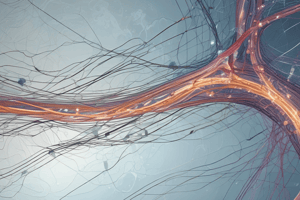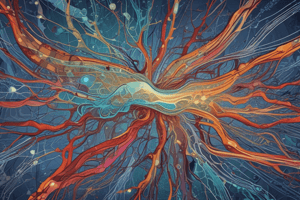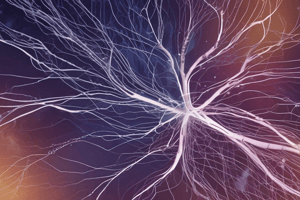Podcast
Questions and Answers
What neurotransmitter is dumped into the synapse of the neuromuscular junction by alpha motor neurons?
What neurotransmitter is dumped into the synapse of the neuromuscular junction by alpha motor neurons?
- Acetylcholine (ACh) (correct)
- GABA
- Serotonin
- Dopamine
What is the effect of administering Botox, a weakened version of botulism, on muscle contraction?
What is the effect of administering Botox, a weakened version of botulism, on muscle contraction?
- Has no effect on muscle contraction
- Causes the muscles to contract by increasing the release of Acetylcholine (ACh)
- Causes the muscles to relax by suppressing the release of Acetylcholine (ACh) (correct)
- Causes muscle stiffness by blocking neuromuscular junctions
What is the impact of black widow venom on the release of Acetylcholine (ACh)?
What is the impact of black widow venom on the release of Acetylcholine (ACh)?
- Causes uncontrollable spasms by increasing the release of Acetylcholine (ACh) (correct)
- Has no effect on the release of Acetylcholine (ACh)
- Causes muscle relaxation by suppressing the release of Acetylcholine (ACh)
- Causes muscle stiffness by blocking neuromuscular junctions
What is the primary cause of Myasthenia Gravis (grave muscle weakness)?
What is the primary cause of Myasthenia Gravis (grave muscle weakness)?
What is the role of curare in muscle paralysis?
What is the role of curare in muscle paralysis?
What happens to the muscles when there are fewer Acetylcholine (ACh) receptors?
What happens to the muscles when there are fewer Acetylcholine (ACh) receptors?
What is the function of antagonistic muscles in joint articulation?
What is the function of antagonistic muscles in joint articulation?
Which part of the brain has a huge number of densely packed neurons?
Which part of the brain has a huge number of densely packed neurons?
What effect does alcohol have on cerebellum activity?
What effect does alcohol have on cerebellum activity?
What is the possible effect of cerebellar lesions?
What is the possible effect of cerebellar lesions?
What is the characteristic gait of people with cerebellar ataxia?
What is the characteristic gait of people with cerebellar ataxia?
What is dysmetria?
What is dysmetria?
What is dysarthria?
What is dysarthria?
What is one of the functions of the cerebellum?
What is one of the functions of the cerebellum?
How does alcohol affect GABA?
How does alcohol affect GABA?
What does the text suggest about visualizing doing something better and better?
What does the text suggest about visualizing doing something better and better?
Which area of the brain is involved in spatial perception and plays a role in spatial planning for movement?
Which area of the brain is involved in spatial perception and plays a role in spatial planning for movement?
Which area of the brain contains mirror neurons that help perceive and understand the actions of others?
Which area of the brain contains mirror neurons that help perceive and understand the actions of others?
Which brain region is crucial for performing sequences of actions to complete tasks?
Which brain region is crucial for performing sequences of actions to complete tasks?
Which brain region is most active at the start of a sequence of actions and prepares the brain for complex tasks?
Which brain region is most active at the start of a sequence of actions and prepares the brain for complex tasks?
Which brain region is involved in learning new actions, and once learned, these actions transfer to the SMA?
Which brain region is involved in learning new actions, and once learned, these actions transfer to the SMA?
Which brain area is responsible for regulating the concept of peripersonal space, the space around an individual for reaching and grabbing objects?
Which brain area is responsible for regulating the concept of peripersonal space, the space around an individual for reaching and grabbing objects?
Which brain region is involved in stopping movements, as observed in the reach memory-guided task experiment with monkeys?
Which brain region is involved in stopping movements, as observed in the reach memory-guided task experiment with monkeys?
What is the role of the corticospinal pyramidal tract?
What is the role of the corticospinal pyramidal tract?
What is the purpose of dermatome mapping?
What is the purpose of dermatome mapping?
What can unilateral impairment of the corticospinal tract lead to?
What can unilateral impairment of the corticospinal tract lead to?
What enables the coordination of complex movements such as walking?
What enables the coordination of complex movements such as walking?
What do M1 neurons in the primary motor cortex of the frontal lobe code for?
What do M1 neurons in the primary motor cortex of the frontal lobe code for?
What did the study of M1 neurons in monkeys reveal about their coding for movement direction?
What did the study of M1 neurons in monkeys reveal about their coding for movement direction?
What do specific neurons with tuning curves exhibit?
What do specific neurons with tuning curves exhibit?
Flashcards
Dorsal and Ventral Roots
Dorsal and Ventral Roots
Sensory signals travel from the body to the spinal cord through the dorsal root via sensory neurons. Motor signals from the spinal cord to the body travel through the ventral root via motor neurons.
Corticospinal Tract (Pyramidal)
Corticospinal Tract (Pyramidal)
This pathway originates in the primary motor cortex and is crucial for voluntary movements, descending towards the brain stem before reaching the spinal cord.
Extrapyramidal Tracts
Extrapyramidal Tracts
These tracts, like the rubrospinal and reticulospinal tracts, work alongside the pyramidal tract, helping with complex movements and balance.
Dermatome Mapping
Dermatome Mapping
Signup and view all the flashcards
Plegia/Paresis
Plegia/Paresis
Signup and view all the flashcards
Hemiplegia/Hemiparesis
Hemiplegia/Hemiparesis
Signup and view all the flashcards
Motor Cortex Topography
Motor Cortex Topography
Signup and view all the flashcards
Central Pattern Generators (CPGs)
Central Pattern Generators (CPGs)
Signup and view all the flashcards
Hierarchical Control of Movement
Hierarchical Control of Movement
Signup and view all the flashcards
M1 Neurons
M1 Neurons
Signup and view all the flashcards
M1 Neuron Coding
M1 Neuron Coding
Signup and view all the flashcards
M1 Neuron Tuning Curves
M1 Neuron Tuning Curves
Signup and view all the flashcards
Intricacies of Neural Signaling
Intricacies of Neural Signaling
Signup and view all the flashcards
Study Notes
Neural Signaling, Motor Pathways, and Spinal Cord Injuries
- Sensory neurons carry touch signals from the body to the spinal cord through the dorsal root, while motor neurons transmit motor signals from the spinal cord to the body through the ventral root.
- The corticospinal pyramidal tract is crucial for voluntary movement and originates in the primary motor cortex, descending down towards the brain stem before reaching the spinal cord.
- Other extrapyramidal tracts include the rubrospinal tract, tectospinal tract, vestibulospinal tract, and reticulospinal tract, each with specific roles in movement and balance.
- Dermatome mapping is used to identify the nerves in the spinal cord that control different areas of the body, with terms like plegia and paresis used to describe paralysis or weakness resulting from spinal cord injuries.
- Unilateral impairment of the corticospinal tract can lead to conditions like hemiplegia or hemiparesis, affecting one side of the body.
- The topography of the motor cortex dictates that body parts with more space in the motor cortex have better motor control, explaining why face and hands take up a significant portion of the motor cortex.
- Movement is still possible following resection of the spinal cord due to the presence of Central Pattern Generators (CPG) in the spinal cord that represent complex movements, allowing for the activation of alternative movement patterns needed for walking.
- Hierarchical Control of Movement involves the brain controlling the central pattern generators, enabling the coordination of complex movements such as walking.
- M1 neurons in the primary motor cortex of the frontal lobe code for the direction of movement, with neural activity being particularly high when the movement is towards the subject.
- The study of M1 neurons in monkeys showed that these neurons code for the direction of movement, as changing the endpoint of the movement did not affect the neural activity, indicating that M1 neurons specifically care about their intended direction.
- Specific neurons have tuning curves, where they are most active for specific movement directions (NEWS), and their neural activity decreases the further away the movement is from that specific direction.
- The study highlights the intricate neural signaling pathways, motor control mechanisms, and implications of spinal cord injuries on movement and motor function.
Studying That Suits You
Use AI to generate personalized quizzes and flashcards to suit your learning preferences.




